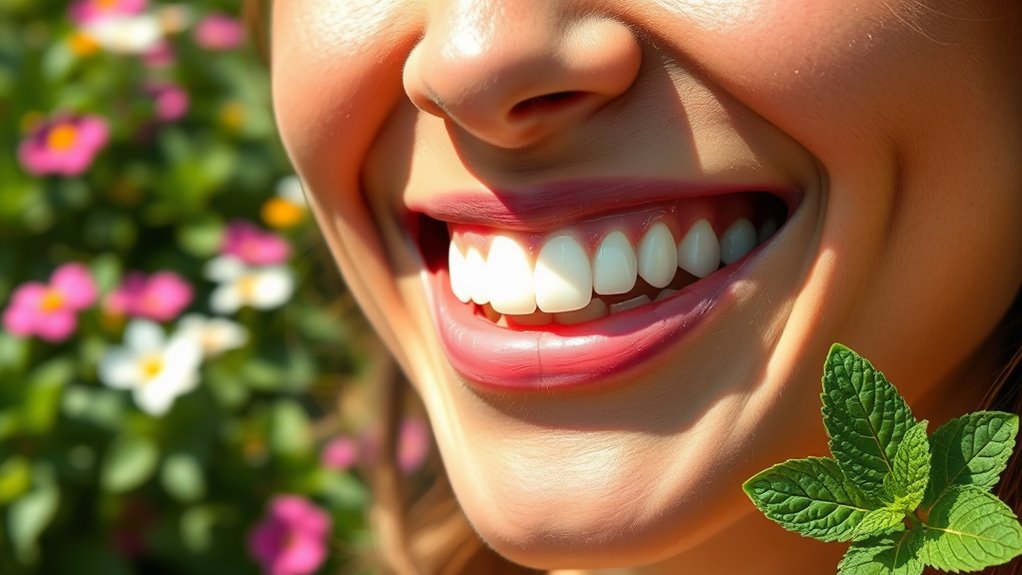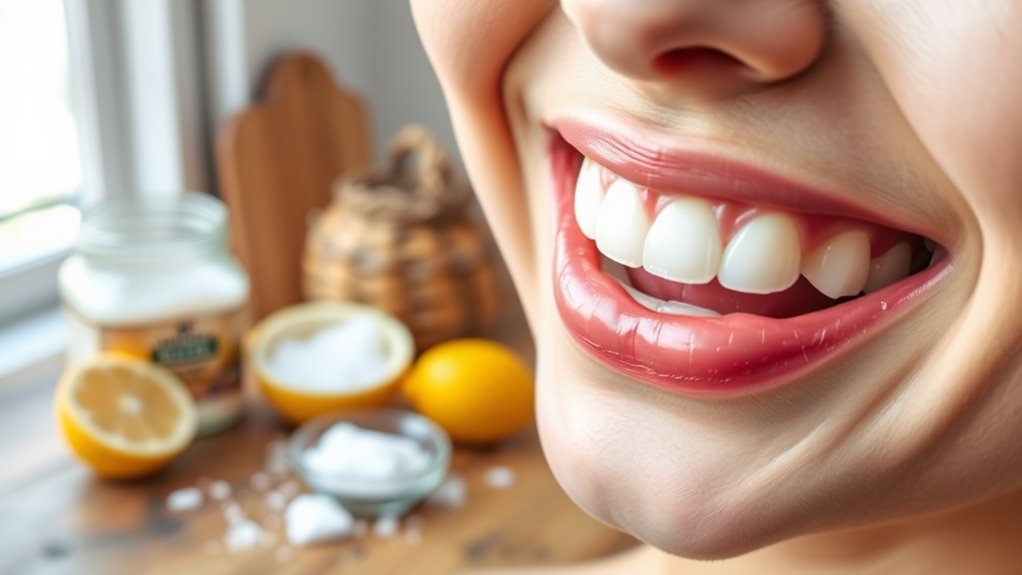This DIY Mouth Rinse Helps With Canker Sores Fast
This DIY mouth rinse helps soothe and heal canker sores quickly. Mix 1 cup of warm water with 1 teaspoon of salt, 1 teaspoon of baking soda, and 1 tablespoon of hydrogen peroxide. Swish the mixture in your mouth for 30 seconds and spit it out. Repeat up to three times a day for relief. The ingredients promote healing and combat inflammation. To discover more tips for effective canker sore relief, continue exploring effective methods.
Key Takeaways
- This DIY mouth rinse combines salt, baking soda, and hydrogen peroxide to promote healing and reduce inflammation in canker sores.
- The rinse helps soothe discomfort by balancing pH levels and disinfecting the mouth effectively.
- Swish the mixture for 30 seconds to 1 minute, up to three times daily, for optimal results.
- Avoid spicy and acidic foods, and stay hydrated to support faster healing of canker sores.
- Incorporate vitamin B12 supplements and stress management techniques to prevent recurrence and maintain oral health.
Understanding Canker Sores
Canker sores, those painful little ulcers that can appear inside your mouth, are more common than you might think. They often manifest as small, round lesions, usually with a white or yellow center and red halo.
While the exact cause isn’t always clear, factors like stress, certain foods, and hormonal changes can trigger them.
Fortunately, you don’t have to suffer in silence. There are effective canker sore remedies available that can help alleviate discomfort and promote healing. Over-the-counter treatments, topical gels, and natural options like honey or aloe vera can provide relief.
Understanding the nature of these sores and exploring available remedies can empower you to manage your symptoms more effectively and get back to enjoying your daily life.
Ingredients Needed for the Mouth Rinse
To create an effective mouth rinse for canker sores, you’ll need a few essential ingredients.
Each component plays a crucial role in soothing discomfort and promoting healing.
Let’s explore the benefits of these ingredients and how to mix them properly for best results.
Essential Ingredients Overview
Creating an effective mouth rinse for canker sores involves selecting the right combination of ingredients. You’ll want to gather the following essential components to guarantee your rinse is both soothing and effective:
-
Salt – Promotes healing and reduces inflammation.
-
Baking Soda – Balances pH levels and helps relieve discomfort.
-
Water – Acts as a base to dissolve other ingredients and hydrates the mouth.
-
Essential Oil (like Tea Tree or Peppermint) – Provides antimicrobial properties and a pleasant taste.
These ingredients work together to create a soothing rinse that targets canker sores effectively.
Benefits of Each Component
While each ingredient in your DIY mouth rinse plays an essential role, understanding their specific benefits can enhance your experience and effectiveness.
For instance, salt is a natural antiseptic that helps reduce inflammation and promotes healing. Baking soda neutralizes acidity, which can soothe irritation while balancing your mouth’s pH.
Hydrogen peroxide acts as a disinfectant, helping to kill bacteria that may aggravate canker sores. Essential oils, like tea tree or peppermint, provide antimicrobial properties and an invigorating taste.
Apple cider vinegar, though potent, can help with inflammation and has antibacterial qualities.
Together, these components create a powerful rinse that not only alleviates discomfort but also supports oral health, making your recovery from canker sores faster and more effective.
Mixing Instructions Explained
Before you start mixing your DIY mouth rinse, gather the essential ingredients to guarantee an effective solution for canker sores.
You’ll need the following items:
- Warm water – 1 cup, to dissolve the other ingredients.
- Salt – 1 teaspoon, to help reduce inflammation and promote healing.
- Baking soda – 1 teaspoon, known for its soothing properties and ability to neutralize acids.
- Hydrogen peroxide – 1 tablespoon, to disinfect and promote oral health.
Once you’ve assembled these ingredients, you’re ready to mix them together.
Combine the salt and baking soda in warm water, stirring until fully dissolved.
Then, add the hydrogen peroxide, ensuring an even mixture.
Your mouth rinse is now ready to use!
Step-by-Step Instructions
To create your DIY mouth rinse, start by gathering all the necessary ingredients.
Once you have everything ready, you’ll mix the components to form your rinse.
Finally, apply the mixture effectively for ideal relief from canker sores.
Gather Necessary Ingredients
Gathering the necessary ingredients for your DIY mouth rinse is crucial for effectively treating canker sores. Having the right components on hand guarantees your rinse is both potent and safe. Here’s what you’ll need:
-
Warm water – This serves as the base for your rinse.
-
Salt – A natural antiseptic that helps reduce inflammation and promotes healing.
-
Baking soda – Balances the pH in your mouth, which can soothe discomfort.
-
Hydrogen peroxide (3%) – This acts as an antibacterial agent to prevent infection.
Be certain to measure these ingredients accurately for the best results.
With these items ready, you’ll be prepared to create a mouth rinse that can help alleviate the pain and irritation of canker sores effectively.
Mixing and Application Process
Now that you’ve assembled the necessary ingredients for your DIY mouth rinse, it’s time to mix them together for effective use.
Start by measuring one cup of warm water and pour it into a clean mixing bowl. Next, add two teaspoons of baking soda and one teaspoon of salt. Stir the mixture gently until both the baking soda and salt dissolve completely.
If you’re using essential oils, add a few drops of peppermint or tea tree oil for added benefits. Once everything’s well combined, pour the solution into a clean bottle for easy storage.
To use, take a small amount, swish it around your mouth for 30 seconds, and then spit it out. Repeat this process up to three times daily.
How the Rinse Works
While you might wonder how a simple mouth rinse can alleviate the discomfort of canker sores, its effectiveness lies in the combination of ingredients that promote healing and reduce inflammation.
This rinse works through several key mechanisms:
-
Antimicrobial properties: It helps fight bacteria that can worsen sores.
-
pH balance: Ingredients neutralize acidity, creating a less hostile environment for healing.
-
Soothing agents: Certain components provide relief from pain and irritation.
-
Healing support: Nutrients in the rinse encourage tissue regeneration, speeding up recovery. Additionally, using natural remedies like oil pulling with coconut oil can further enhance oral health and prevent conditions that may lead to canker sores.
Additional Tips for Canker Sore Relief
In addition to using a DIY mouth rinse, there are several other strategies you can implement to ease the discomfort of canker sores.
First, consider applying a topical anesthetic to numb the area and reduce pain. Over-the-counter options like benzocaine can provide quick relief.
You should also avoid spicy, acidic, or abrasive foods that may irritate the sores further. Staying hydrated is essential, so drink plenty of water to help your body heal.
Additionally, incorporating a vitamin B12 supplement may promote faster recovery.
Stress management techniques, like deep breathing or meditation, can also play a role in preventing outbreaks.
Finally, maintain good oral hygiene by gently brushing your teeth and using a soft-bristled toothbrush.
When to Seek Professional Help
If you’ve tried various home remedies without relief, it might be time to seek professional help for your canker sores. Recognizing the right moment to consult a healthcare provider is essential.
Here are some signs that indicate you should reach out:
-
Severe pain: If your sores cause unbearable discomfort or hinder daily activities.
-
Persistent sores: When canker sores last longer than two weeks without improvement.
-
Frequent outbreaks: If you experience recurrent sores more than three times a year.
-
Signs of infection: If you notice increased redness, swelling, or pus around the sores.
Don’t hesitate to consult a professional; they can provide effective treatments and help address any underlying issues contributing to your canker sores.




